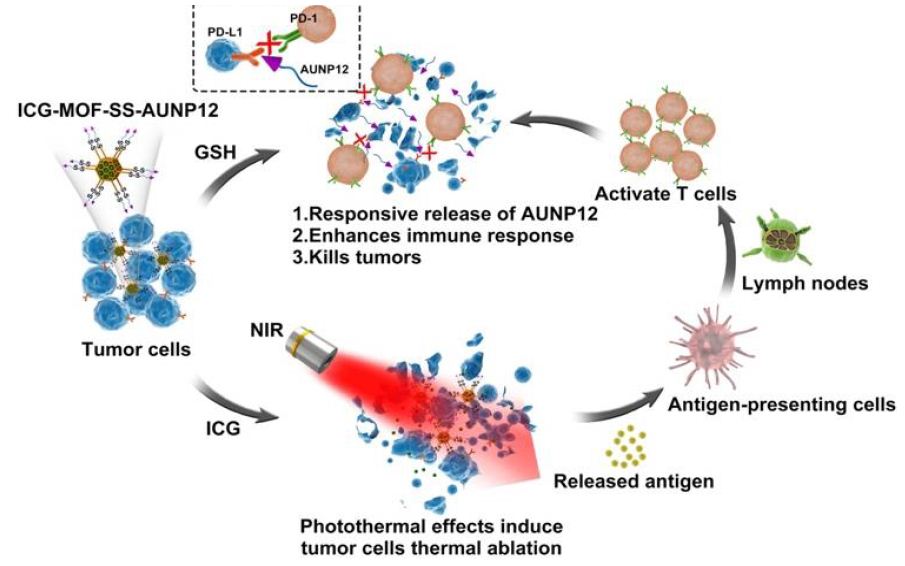Abstract
Original research on the application of MOF-based nanodrugs for photothermal and immune therapy of melanoma has been developed. This study, aimed at addressing the limitations of melanoma treatment, constructed indocyanine green (ICG) loaded GSH-responsive PD-1 inhibitory polypeptide AUNP12-modified MOF nanodrugs for photothermal and immune therapy of melanoma. The AUNP12 could be released to bind PDL-1, effectively blocking the PD-1/PD-L1 pathway at high concentrations of glutathione (GSH). This MOF-based nanodrugs could promote the maturation of DC cells, while the ICG exhibits strong photothermal effects, achieving synergistic photothermal and immunotherapy for melanoma.
MOF-based Nanodrugs for Melanoma Treatment General Achievements
Melanoma is a cutaneous neoplasm arising from the malignant transformation of melanocytes, exhibiting a high degree of malignancy and a propensity for metastasis, thereby resulting in a poor clinical prognosis and a heightened fatality rate [1]. The chief limitations of traditional clinical interventions (surgery, radiation therapy, and chemotherapy) primarily lie in their limited efficacy in suppressing metastatic lesions and their substantial toxic and side effect [2]. Hence, the focal point in the clinical management of malignant melanoma is how to efficaciously inhibit its growth and metastasis with reduced toxicity, constituting a pivotal juncture in clinical practice and a current scientific research challenge.
Immunotherapy has recently emerged as an advanced therapeutic strategy with attracted widespread attention in clinical and foundational research. Immune checkpoint blockade holds promise in the treatment of melanoma, particularly through the inhibition of programmed cell death protein-1 (PD-1)/programmed cell death ligand-1 (PD-L1) [3]. Nevertheless, the currently available immunotherapeutic antibodies targeting melanoma exhibit expensive, considerable toxicity, robust immune reactions, and substantial interindividual variability. In contrast, PD-1 inhibitory peptide AUNP12 (AUR-12/Aurigene-012), developed by Aurigene and Pierre Fabre, is characterized by its affordability and minimal adverse effects and is presently in the preclinical research phase [4].
Nevertheless, research has illuminated the limited efficacy of singular immune checkpoint blockade in restraining tumor growth and metastasis [5]. A synergistic approach, with methodologies such as chemotherapy, photodynamic, or photothermal therapy, can amplify therapeutic potency [6,7]. Photothermal therapy, an exceedingly promising novel method for tumor treatment, relies on the conversion of external light sources into localized thermal energy to kill neoplastic cells, particularly suitable for cutaneous malignancies. Remarkably, studies have also reported the capability of photothermal therapy to stimulate an immune response within the host organism, by generating endogenous antigens during the thermal ablation of tumor tissue, subsequently activating cytotoxic T cells [8,9]. Therefore, the synergistic treatment of immune checkpoint blockade and photothermal therapy holds extensive promise in the management of melanoma.
This work “The GSH responsive indocyanine green loaded PD-1 inhibitory polypeptide AUNP12 modified MOF nanoparticles for photothermal and immunotherapy of melanoma” has designed and constructed a nanomedicine that combines the photothermal and immunotherapy [10]. Through click chemistry, AUNP12, linked by disulfide bonds, was modified onto the surface of a metal-organic framework (MOF) and loaded with the photothermal converter indocyanine green (ICG) which has strong photothermal effect. The PD-1 inhibitory peptide AUNP12 could be responsive release from MOF-based nanodrug and promote the maturation of DC cells, which combine with the ICG to achieve synergistic photothermal and immunotherapy for melanoma (Figure 1).

Figure 1: The schematic diagram of ICG-MOF-SS-AUNP12 nanoparticles for synergistic photothermal and immunotherapy.
Conclusion
The MOF-based nanodrugs exhibits potent photothermal effects for tumor cell ablation while intelligently releasing PD-1 inhibitory peptides to enhance DC cell maturation. The study primarily furnishes a concept of substantial value, albeit at a relatively preliminary stage. With a clinical translation objective in mind, the exploration of a secure and efficacious delivery modality for nanomedicines is essential in the future. Taking into account the unique biological characteristics of melanoma, a comprehensive research effort is currently underway to explore alternative drug delivery methods, such as microneedle-based transdermal delivery, with the ultimate goal of developing innovative treatment strategies for this deadly cancer.
Acknowledgements
This work was financially supported by the National Natural Science Foundation of China (32101134, 32101161), Program of Science and Technology Department of Sichuan Province (23NSFSC0884, 2022YFS0203), the Technology Innovation Project of Science and Technology Bureau of Chengdu (2022-YF05-01468-SN, 2022-YF05-01724-SN).
References
- Garbe C, et al. (2022) European consensus-based interdisciplinary guideline for melanoma. European Journal of Cancer 236-255. [crossref]
- Long GV, et al. (2023) Cutaneous melanoma. Lancet 485-502.
- Kubli SP, et al. (2021) Beyond immune checkpoint blockade: emerging immunological strategies. Nature Reviews Drug Discovery 899-919. [crossref]
- Zhan MM, et al. (2016) From monoclonal antibodies to small molecules: the development of inhibitors targeting the PD-1/PD-L1 pathway. Drug Discovery Today 1027-1036.
- Chen W, et al. (2018) Combining photothermal therapy and immunotherapy against melanoma by polydopamine-coated Al2O3 nanoparticles. Theranostics 2229-2241. [crossref]
- Lu J, et al. (2018) Breast Cancer Chemo-immunotherapy through Liposomal Delivery of an Immunogenic Cell Death Stimulus Plus Interference in the IDO-1 Pathway. ACS Nano 11041-11061. [crossref]
- Li Y, et al. (2019) Nanotechnology-based photoimmunological therapies for cancer. Cancer Letters 429-438. [crossref]
- Huang L, et al. (2019) Mild photothermal therapy potentiates anti-PD-L1 treatment for immunologically cold tumors via an all-in-one and all-in-control strategy. Nature Communications 4871.
- Balakrishnan PB, et al. (2020) Photothermal therapies to improve immune checkpoint blockade for cancer. International Journal of Hyperthermia 34-49. [crossref]
- Hao Y, et al. (2023) The GSH responsive indocyanine green loaded PD-1 inhibitory polypeptide AUNP12 modified MOF nanoparticles for photothermal and immunotherapy of melanoma. Frontiers in Bioengineering and Biotechnology. [crossref]